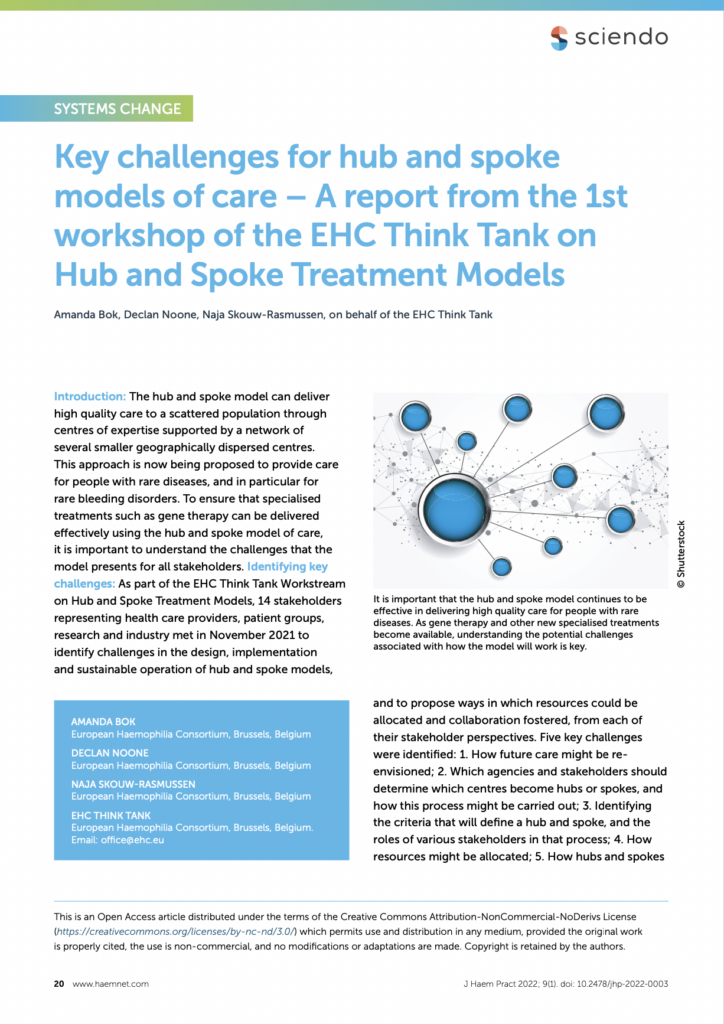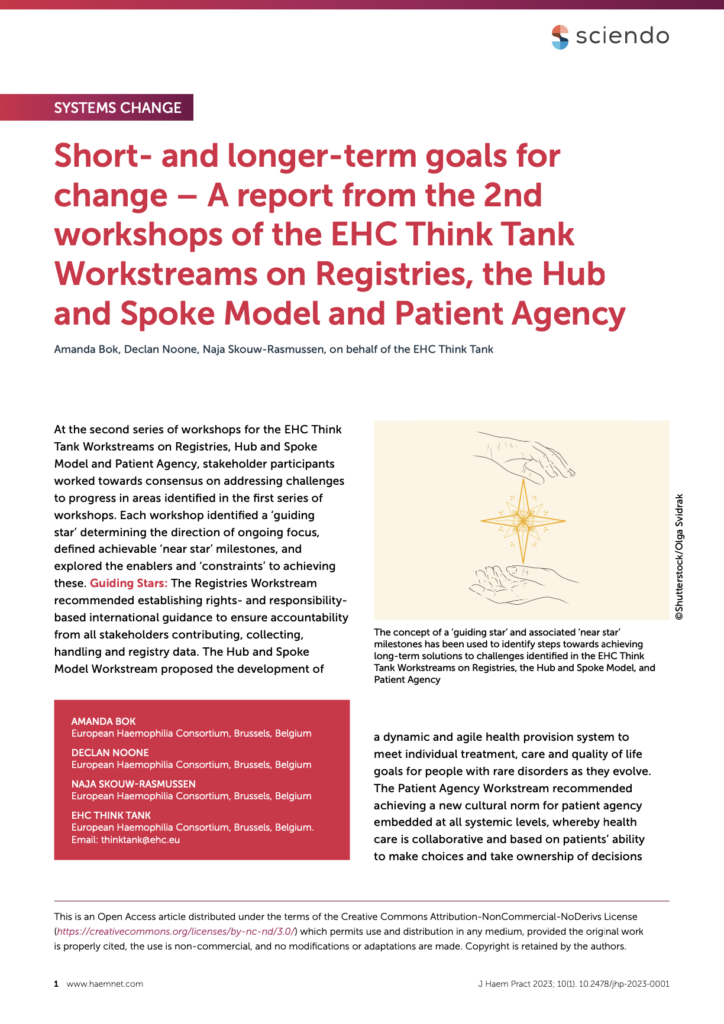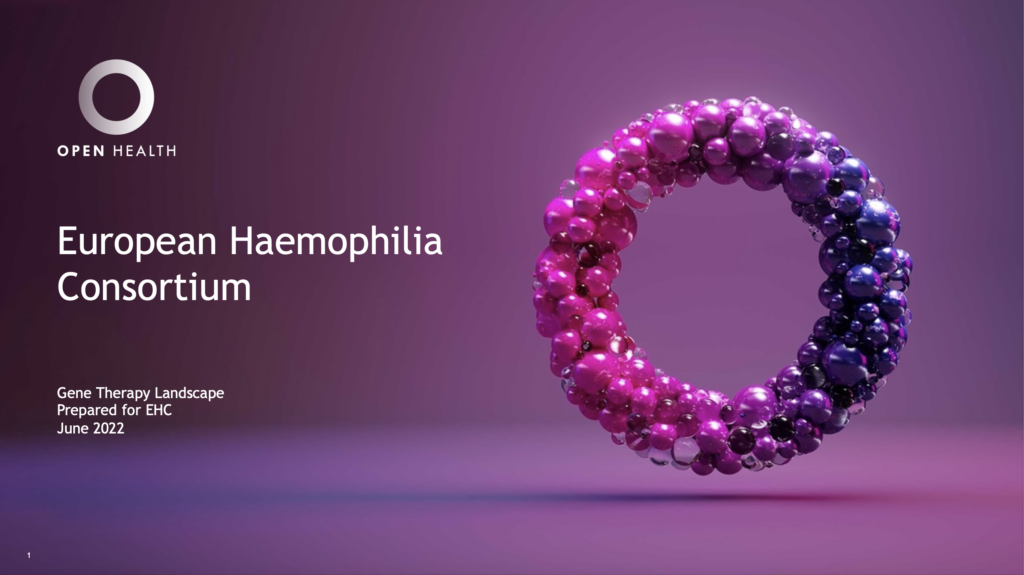The Hub & Spoke Model workstream explores future treatment and care pathways, building on international calls for a hub-and-spoke model approach.
About the workstream
The hub & spoke model workstream explores future treatment and care pathways, building on international calls for a hub-and-spoke model approach. Traditionally, the health needs of people with a bleeding disorder have been addressed by haemophilia treatment centres and/or comprehensive care centres. The roles and links between these tiered centres are due a revision: first, in order to accommodate the safe introduction, use and monitoring of – as well as real-world learnings from – ever evolving novel therapy options, such as ATMPs; and second, to ensure optimal application and use of evolving technologies such as point-of-care devices, telemedicine tools, etc. Both these developments will deeply influence the evolution of disease progression and associated impacts on patients’ physical and mental wellbeing.
Therefore, this workstream considers how such changes can be preemptively addressed, before potentially manifesting as system problems.
Composition
The composition of the workstream aims to reflect the diversity of key actors who have hands-on knowledge of challenges and possible solutions in this thematic area. This includes, but is not limited to: patients, healthcare professionals, industry partners, private companies, policymakers, researchers, and academics.
The general membership profile is built around required skill sets and may evolve throughout the co-creation process. The initial skill sets include the ability to ‘problem map’ salient points and their relationships, requiring:
- Hands-on knowledge of the topic area,
- Genuine willingness to learn about, and actively contribute to, a systems change culture,
- Experienced, analytical, open, hands-on ability to remove stakeholder ‘hats’, and
- Respect of Chatham House Rule and culture of conduct and engagement.
Each workstream brings together 16-20 individuals, which is broad enough to ensure a comprehensive overview, while small enough to be workable.
Public outcome
- As part of sharing the outcome of the work of the EHC Think Tank, the first paper from the workstream on hub and spoke model is now published. In this paper, workstream members identify 5 key challenges in the design, implementation, and sustainable operation of hub and spoke models, and propose ways in which resources could be allocated and collaboration fostered. This paper will be the first in a series of outcomes aiming to synthesise how we might develop a hub and spoke model of care. Bok A, Noone D, Skouw-Rasmussen N, EHC Think Tank. Key challenges for hub and spoke models of care – A report from the 1st workshop of the EHC Think Tank on Hub and Spoke Treatment Models. The Journal of Haemophilia Practice. 2022;9(1): 20-26. https://doi.org/10.2478/jhp-2022-0003
- At the second series of workshops for the EHC Think Tank Workstreams on Registries, Hub and Spoke Model and Patient Agency, stakeholder participants worked towards consensus on addressing challenges to progress in areas identified in the first series of workshops. Each workshop identified a ‘guiding star’ determining the direction of ongoing focus, defined achievable ‘near star’ milestones, and explored the enablers and ‘constraints’ to achieving these. Bok A, Noone D, Skouw-Rasmussen N, EHC Think Tank. Short- and longer-term goals for change – A report from the 2nd workshops of the EHC Think Tank Workstreams on Registries, the Hub and Spoke Model and Patient Agency. https://sciendo.com/article/10.2478/jhp-2023-0001
- OPEN Health have conducted desk research on gene therapy services in the European Union to understand how the service is currently set up, run, and funded, and how they may change in the future. Potential challenges for access to gene therapies and key gaps have also been identified. Gene Therapy Landscape by OPEN Health
System map of the underlying challenges
A system map is a methodology to better understand a particular issue by visualising the challenges, related constraints, and enablers. The system map aims to give an overview of the issue at hand while balancing the need for detail.
The map is built from the participants’ discussions and vetted by participants throughout its development. The key challenges identified are:
- Delivery of gene therapy
- Resource allocation
- Criteria for hubs and spokes
- Collaboration between hub and spokes
- Knowledge distribution
- Re-envisioning delivery of treatment in the future
It is important to remember that the system map illustrates the situation here and now, and does not include ideas and wishes for the future. Thus, it is dynamic and should look different in the future as initiatives evolve, resource flows change, opportunities arise, or new challenges occur.
The map is interactive and gives you an opportunity to zoom in on particular circles and connections and zoom out to see the bigger picture of connections. For a larger view you can open the map in a separate window by clicking on this link.
If you want to know more or contribute intellectually, please reach out to us.



